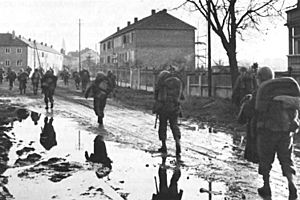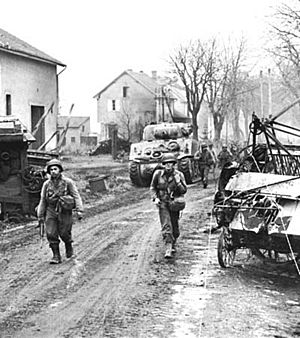Battle of Metz facts for kids
Quick facts for kids Battle of Metz |
|||||||||
|---|---|---|---|---|---|---|---|---|---|
| Part of the Lorraine Campaign, World War II | |||||||||
 Troops of the U.S. 5th Infantry Division entering Metz on 18 November 1944. |
|||||||||
|
|||||||||
| Belligerents | |||||||||
| Commanders and leaders | |||||||||
| George S. Patton | Otto von Knobelsdorff | ||||||||
The Battle of Metz was an important fight during World War II. It happened in the city of Metz, which was then part of Nazi Germany. The battle lasted from late September to mid-December 1944. It was part of the Lorraine Campaign. The main groups fighting were the U.S. Third Army, led by Lieutenant General George S. Patton, and the German Army, led by General Otto von Knobelsdorff. Both sides faced many difficulties and lost many soldiers. The U.S. forces eventually captured the city. The fighting officially ended on November 22, but the last forts defending Metz didn't give up until December 13.
Contents
Why Metz Was Important
Metz is a city located between two rivers, the Moselle and the Seille. It had strong defenses made up of many forts, observation posts, tunnels, and trenches. These defenses were known as the fortifications of Metz.
When France was defeated in 1940, German forces took control of Metz. The city became part of the Third Reich. At first, the German army didn't think Metz was very important. Many of its guns and equipment were moved away. However, the forts were still well-built and defended.
The Allied Advance and German Plans
After the Allies broke out from their landing area in Normandy, the U.S. Third Army moved very quickly across France. German forces were retreating in a messy way. But as the U.S. army moved further, their supply lines stretched out. They started to run low on important things like gasoline.
Because of this, General Dwight D. Eisenhower, the Supreme Commander, told the Third Army to pause. This pause was to gather supplies for a big plan called Operation Market Garden. This plan aimed to get into Germany's important industrial area, the Ruhr Valley.
This pause gave the Germans time to get organized. They used this time to make Metz stronger. They hoped to stop the Allied advance there.
By the end of August 1944, German forces had set up a new defense line around Metz and Nancy. Hitler had given an order in March 1944 that fortress commanders must hold their positions no matter what. They could only surrender if Hitler said so, which he never would.
The forts around Metz were originally built by the Germans between 1870 and 1919. They were later neglected by the French. When Germany took back the area in 1940, these forts became important again. Hitler knew the U.S. Third Army was a threat to the Saar region of Germany. He ordered his commanders to stop the Allies as far west as possible. This would give Germany time to strengthen their main defense line, the West Wall.
The German First Army, led by General Otto von Knobelsdorff, was in charge of defending Metz. They had a large number of troops, equal to about four and a half military divisions.
The Battle Unfolds

In early September 1944, U.S. scouting units from the XX Corps met German forces near the Moselle river. The U.S. soldiers didn't expect the Germans to be there. They had to quickly bring their scattered units together. After this, the U.S. forces made several small attacks.
The first major U.S. attack was by the 95th Infantry Division. They tried to capture a bridgehead (a secure area across a river) north of Metz. But the German forces pushed them back. Another attack on the city also failed. However, the U.S. forces did manage to capture a small bridgehead across the Moselle south of Metz.
By the end of September, German troops from the north of Metz had moved to the southern area. Some troops were also pulled out of Metz. After this, the XII Corps launched another attack, but the German defenders stopped them. For the next two weeks, U.S. forces mostly did small attacks and patrols around Metz. During this time, the XX Corps trained and tried out new ways to break through the strong fortress defenses. The U.S. command decided to attack Metz from the east, hitting it from behind.
On November 3, the U.S. forces launched a new attack. They used the new tactics they had learned. This helped them capture the outer defenses of Metz. On November 14, Generalleutnant Heinrich Kittel became the new German commander. By November 17, U.S. forces had managed to surround most of the forts. They were now attacking the city itself.
German forces began to retreat on November 17. U.S. forces chased them for the next two days. U.S. soldiers entered Metz on November 18. On November 21, Kittel was wounded and captured. Even though the city was taken by U.S. forces and the fighting officially stopped on November 22, some isolated forts continued to resist.
The U.S. command decided not to directly attack these remaining forts. This was to save artillery ammunition for the XX Corps' next move towards the Sarre River. So, the isolated forts surrendered one by one. Fort Verdun surrendered on November 26. By the end of November, several forts were still holding out. The very last fort in Metz to surrender was Fort Jeanne d'Arc. It gave up to the U.S. III Corps on December 13.
What Happened After
The Battle of Metz was a defeat for the German forces. However, it did help them achieve their goal. It slowed down the advance of the U.S. Third Army for about three months. This gave the retreating German forces time to pull back in an organized way to the Sarre river and set up their defenses there. Both sides had many casualties, meaning many soldiers were wounded or killed. The exact numbers are not known, but they were high.



